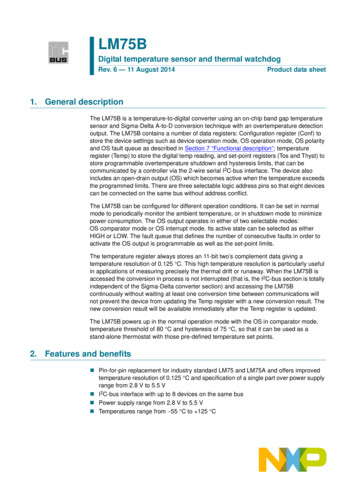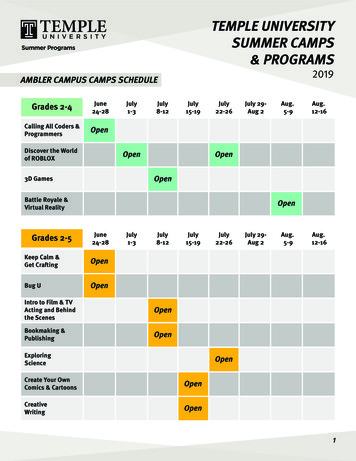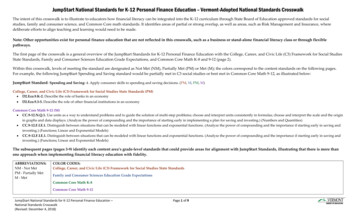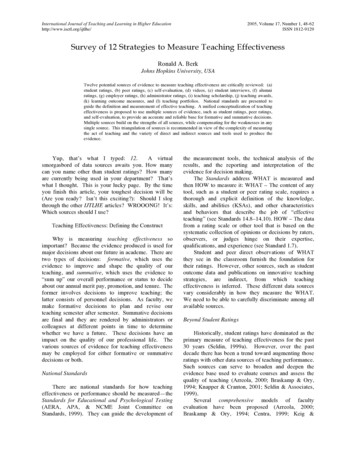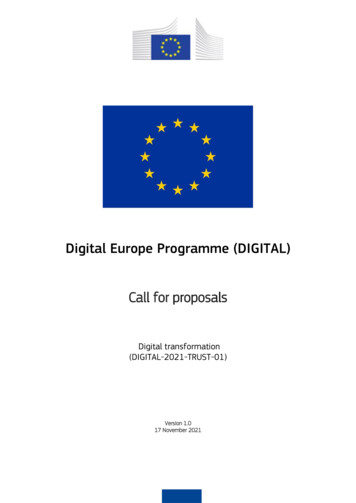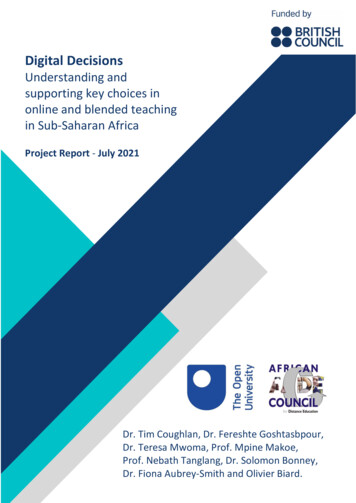
Transcription
Digital DecisionsUnderstanding andsupporting key choices inonline and blended teachingin Sub-Saharan AfricaProject Report - July 2021Dr. Tim Coughlan, Dr. Fereshte Goshtasbpour,Dr. Teresa Mwoma, Prof. Mpine Makoe,Prof. Nebath Tanglang, Dr. Solomon Bonney,Dr. Fiona Aubrey-Smith and Olivier Biard.
Key findingsThe Digital Decisions project analysed how staff in Higher Education Institutions (HEIs) in Ghana,Kenya, Nigeria and South Africa made decisions to make greater use of online learning. We exploredchallenges, how key decisions were made, and the impacts of these on students and staff. We alsogathered views on good practices in digital decision making. Key findings of the project are that:What were the challenges? Key difficulties in decision making were that staff lacked essentialknowledge and skills, and that the primary tool for their work – a technology-mediated connectionbetween them and the students - was constrained and not consistently available for all. Staff facedchallenging decisions when they noticed limited attendance by students, who for reasons such astiming, awareness, connectivity or availability of appropriate devices, were not engaging as expected.Pedagogical decisions were challenging because accepted approaches in areas such as assessmentwere known to not be suitable to online learning. Staff may know what they were aiming to achieve(for example, increased engagement of students with teachers and peers) but not how to achieve this.Alternatives to accepted approaches were unfamiliar, or not in line with policies (such as the use ofsocial media tools for teaching, or moving away from face to face exams).What types of decisions were made? Rule and policy related decisions were a common focus, giventhat the existing policies were not appropriate to online and blended learning. These could take timebut were ultimately seen as important and beneficial to progress in delivering effective online andblended teaching. As noted above, pedagogical decisions in areas such as assessment and activitieswere also commonly required.Decisions to proactively reach out and engage with the student community were seen to be essential,recognising their unfamiliarity and potential lack of motivation or confidence to engage online. Staffbecame aware that their roles were changing, and this could prompt concerns for their jobs as wellas interest in personal development.How did decision making happen? In the context of the pandemic, providing continuity of teachingwas the key objective influencing senior management decisions across the whole institution. Otherstaff made decisions in their areas with the objective of teaching and supporting students effectivelythrough a period of substantial change. Tensions were apparent between the objectives of individualdecision makers and their communities, rules and tools. These tensions had to be accounted for indecision-making, such as in considering limited staff capacity to deliver the desired training or coursecreation activities, and making choices about tools that some students were not be able to access.The use of new forms of communications technology for making and communicating decisions wasvery apparent – staff as well as students adapted to new ways of working across locations. There werepositive stories about the use of tools among staff, but decision making about tools for teaching werefraught with tensions, due to the problems of connectivity and device availability already mentioned.What were the impacts of decisions? In line with the key objective, the primary impact of thesedecisions on students was seen to be a continuation of teaching and the mitigation of pandemicrelated disruption. This can appear to be distinct from using technology to innovate or offer a betterstudy experience to students, however there was evidence that the decisions had supportedimproved opportunities and access to learning materials, prompted students to develop their digital1Digital Decisions: Understanding and supporting key choices inonline and blended teaching in Sub-Saharan Africa
literacies, and increased satisfaction for some. There were also opportunities to have a positive impacton areas such as assessment, which already required attention. The majority of staff saw positiveimpacts for students, but there was recognition that some students had no ability to access theinternet at all, were left behind, and needed to be supported in other ways.The positive impacts aligned well with institutional goals of offering flexible and accessible learning,overcoming barriers of distance. There was also a recognition that the resilience of teaching hadimproved and that this could be beneficial in the future, with more ability to teach through any crisisor unpredictable event they could face. For staff, valuable skills had been developed, but for some,workload had increased to a worrying level.What good practices should be shared? The experiences of participants led them to describe a rangeof practices that had positive impact. Attention to these in decision making should be effective forother staff and institutions as they move online. Good practices in pedagogy include the introductionof continuous and formative assessment, proactive communication with students and clearinformation about course activities, and, in blended learning, identifying how to make best use of thecombination of in-person and online study time.Institutional policies need to be revised to be appropriate to online and blended learning. Someflexibility in the application of policies can also be important to support staff to deliver teaching forstudents in any interim period before this is complete. Institutional strategies should also look tocompensate staff for new costs incurred in order that they can complete their work, and incentivisetheir efforts to learn and adapt to new ways of working. Along with workload planning and harnessingof benefits such as sharing resources across locations, this can encourage a positive attitude towardsthese changes among staff.The project co-created a professional development resource that summarises key areas of decisionmaking and related good practices: Making Digital Decisions. This resource encapsulates findings ongood practices in a practical format, with a set of ‘Key decisions’ and guidance on good practice acrosssix themes derived from the project workshops: Upskilling staff and studentsChanging the pedagogyOvercoming barriersWorking togetherEffective strategies for teachingAchieving qualityThis report complements the Making Digital Decisions resource by providing a rich and more detailedanalysis of our findings.2Digital Decisions: Understanding and supporting key choices inonline and blended teaching in Sub-Saharan Africa
ContentsKey findings1Contents3Project Team4Introduction and background5Methodology7Participants and recruitment process7Data collection8Narratives8Online workshops8Data analysisActivity TheoryResearch FindingsRQ1: Challenges experienced by staff81011111.Subject-related challenges122.Tool and technology-related challenges143.Community-related challenges164.Pedagogy and delivery-related challenges185.Rule and policy-related challenges206.Challenges related to the division of labour (tasks)22RQ2: Types of decisions made to teach or support students online231.Rule and policy related decisions232.Pedagogical decisions253.Community-related decisions274.Tool and Technology-related decisions285.Subject-related decisions306.Decisions related to the division of labour31RQ3: How decisions were made33Decision objectives33Mediating tools33Rules, regulations and procedures34Community35Sharing of tasks (division of labour)35Tensions363Digital Decisions: Understanding and supporting key choices inonline and blended teaching in Sub-Saharan Africa
CASE ONE: Exam coordinator and lecturer (University A)38CASE TWO: Lecturer (University D)40CASE THREE: Director of learning content management systems (University C)42CASE FOUR: IT facilitator (University B)44RQ4: The impact of decisions451.Impact on students and their learning452.Impact on teaching and course delivery483. Impact on staff504.51Impact on universitiesRQ5: Good practices53Pedagogy-related good practices53Good practices related to university policies and procedures54Staff support and collaboration55Adjusting to change56Course or module delivery57Conclusion: Contextualising research to develop good practices for digital decision making59Working together59Upskilling staff and students59Changing the pedagogy60References61Appendix A: Narrative reflection prompts63Project Team Dr. Tim Coughlan (Institute of Educational Technology, The Open University UK)Dr. Fereshte Goshtasbpour (Institute of Educational Technology, The Open University UK)Dr. Teresa Mwoma, (African Council for Distance Education and Kenyatta University, Kenya)Olivier Biard (International Development Office, The Open University UK)Prof. Mpine Makoe (UNISA, South Africa)Prof. Nebath Tanglang (National Open University of Nigeria, Nigeria)Dr. Solomon Bonney (Laweh Open University College, Ghana)Dr. Fiona Aubrey-Smith (Faculty of Wellbeing, Education and Language Studies, The Open UniversityUK and independent consultant)For more information, please contact Tim Coughlan (tim.coughlan@open.ac.uk) or visit the DigitalDecisions website.4Digital Decisions: Understanding and supporting key choices inonline and blended teaching in Sub-Saharan Africa
Introduction and backgroundThe Digital Decisions project was funded by the British Council and led by The Open University UK (OU) andThe African Council for Distance Education (ACDE). Running from February to July 2021, it examined thechoices made and experiences of moving towards greater online and blended teaching in four highereducation institutions (HEIs) across Ghana, Kenya, Nigeria and South Africa.The aim was to explore how institutions and staff make decisions at the conflux of pedagogy, technologyand student support, the impacts of these decisions, and good practices that can be drawn from theseexperience and related literature.The primary data source collected in the project were narratives of decision making from 84 participantsacross these institutions. Activity Theory was used as an analytical lens through which these decisions andthe contexts in which they were made could be represented and considered. Thematic analysis was used toidentify topics and issues in this data. Two online workshops with representatives from each of the fourinstitutions were used to discuss and augment these findings, and to co-create a professional developmentresource that sits alongside this report as the primary outputs of the project.Some African universities have made use of online and blended learning since the 1990s and 2000s (e.g.Bagarukayo & Kalema, 2015; Tarus & Gichoya, 2015). However, adoption has been considered to be slowerthan in other parts of the world, with challenges ranging from the lack of training and heavy workloads forlecturers to the limited Internet connectivity available for students. Negative attitudes towards onlinelearning can also exist, perhaps caused in some cases by limited use of the full potential of eLearning to offeran engaging alternative to in person teaching (Mutisya & Makokha, 2016).The upheaval caused by the Covid-19 pandemic radically increased the impetus in shifts to online andblended learning. Governments required educational institutions to close, but the clear potential fordistance learning approaches to mitigate the impacts of these closures was not consistently supported.Situations and responses varied but common issues included a lack of access to technology, homeenvironments that were not suited for study, and barriers to accessing learning materials (eLearning Africa& EdTech Hub, 2020).Shifts towards greater online teaching and learning are complex and combine pedagogical, technological,administrative, pastoral and strategic elements. Institutions and their staff had variable knowledge,processes and infrastructure to draw on at this time, and the situation required strategic institutionaldecisions as well as decisions made by staff in their individual roles. The importance of both these aspectsled us to a methodology that could explore both individual decisions and the contexts in which they weremade.The project team were also aware of the importance of upskilling staff and of supporting them to share andreflect on their experiences of these shifts in their working practices. Digital Decisions followed a rapidresponse project, Pathways for Learning, which delivered free online training for HEI staff across Africa inJuly - August 2020. Live events were attended by over 500 participants, and almost 300 completed the‘Tertiary Educator’ programme involving study of a 24 hour Badged Open Course alongside a six weekschedule of events.Data from the surveys and learning activities included in Pathways for Learning provided a starting point forthe development of this project and gave us initial themes for further exploration. Most participants hadexperienced a shift to online teaching and greater use of technology during the pandemic, and comments5Digital Decisions: Understanding and supporting key choices inonline and blended teaching in Sub-Saharan Africa
showed that there was an expectation for many of the changes made to become more permanent. At thesame time, a variety of barriers restricted the adoption of effective online or blended learning, ranging froma lack of confidence in students and staff, through to national or institutional policies that restrict assessmentto in person examinations.The report provides a detailed analysis of the findings related to each of the five research questions. In linewith the British Council initiative that has supported the project, this aims to form part of a growingunderstanding of the Digital University in Africa, and in particular, the digital literacy, skills and competenciesrequired of academics, professional services, university leaders and students.6Digital Decisions: Understanding and supporting key choices inonline and blended teaching in Sub-Saharan Africa
MethodologyAs described in the introduction, pedagogical, technological, administrative, strategic and pastoral decisionsmade by staff in different roles play a critical role in creating a successful and engaging online learningexperience for university students. To understand these decisions better and to facilitate making of them,this project specifically focused on the following research questions:RQ1RQ2RQ3RQ4RQ5What challenges did universities’ academic and support staff experience in delivering onlineand blended learning?What decisions did they commonly have to make in order to teach or support studentsonline?How did they make such decisions?What kinds of impacts did these decisions then have?What good practices can be identified in relation to these common decisions?To address these questions, a narrative approach was chosen as it allowed participants to share the storiesof their decisions while reflecting on their actions (Schön, 1987) and revisiting the rationale and impacts oftheir choices. It also enabled us to hear the personal stories of individual participants as well as the collectivenarrative of the university staff community (Murray, 2018). From different methods of narrative datacollection, audio narratives were decided to be an effective means to gather the accounts from participants.However, to afford flexibility, they could provide a written narrative as an alternative if they preferred.Ethical approval for the research was received from the Human Research Ethics Committee of the OpenUniversity (HREC/3897/Coughlan).Participants and recruitment processNarratives were collected from 84 university staff in academic, support, technical and senior managementpositions from four institutions in Kenya, Ghana, Nigeria and South Africa. Each institution had increased useof online teaching due to the pandemic, building on diverse experiences in delivering forms of online andblended teaching prior to this.In order to recruit participants within each institution, purposeful sampling was applied; however, differentapproaches were used for each institution due to the context and practicalities (e.g., the processes ofdecision-making in some institutions were distributed among different roles or teams while in others it waslimited to one person). As a result, whilst purposeful sampling in terms of ensuring participants have a rolein the overall decision-making process was implemented, the steps taken to identify and select participantswere not the same in the four institutions.In each institution, an understanding of who is involved in making decisions about delivering and supportingstudents online was established through working with a representative of that institution, and then a list ofstaff to be invited to participate in the project was produced. Participants on the list were sent an invitationemail and the project information leaflet. Volunteer invitees were then briefed about the project and wereasked to record their narratives.7Digital Decisions: Understanding and supporting key choices inonline and blended teaching in Sub-Saharan Africa
Data collectionNarrativesThe project collected one narrative (requested to be 2-5 minutes in length) from each participating staffmember over a period of 45 days. Participants were given instructions as to how to record their narrativesas well as a number of prompts (please see Appendix A) to facilitate their reflection. These prompts wereinformed by the research questions and conceptual framework underpinning the project’s research design,i.e. Activity Theory.84 narratives were received from across the four institutions. These comprised 25 narratives from UniversityA, 24 from University B, 27 from University C, and 8 from University D. 32 participants were female and 51male1. While there were challenges to capturing a similar number of narratives from University D, thosereceived were rich and diverse enough to provide good insights and were supplemented by the workshopactivities in which a group of University D staff were strongly engaged.Online workshopsThe analysis of the narratives was supplemented with two follow-up workshops, each lasting for two hours,with a sample of volunteer participants. These gave the participants and project team an opportunity toreflect upon particular aspects of what they reported and to place their narrative within a larger narrativeframe. The first workshop involved group activities focused on each of the research questions. For this,participants were introduced to the initial findings of the narrative analysis, and were then given questionsto discuss. Most of the activities were conducted in smaller breakout groups, with attendees split up in twodifferent ways: cross-institutional groups to provide opportunities to reflect on the experience of decisionmaking and the impacts of this with those from the other institutions, and within-institution groups todiscuss decision making structures and division of labour within their own institution.The second workshop was specifically planned to help address RQ5 about good practices and to design aprofessional development resource to guide future decision making. The resource aims to guide staff andinstitutions who are moving to greater use of online and digital learning. It is available from the DigitalDecisions website.22 attendees joined the first workshop, and 18 joined the second workshop (in addition to the organisers).In both cases these included staff from each of the four institutions involved in the data collection.The workshops were delivered online and were recorded. Recordings were then transcribed, and sectionsrelated to research questions were analysed to supplement data from narratives.Data analysisThe recorded narratives were transcribed, and the transcriptions were analysed in two phases using ActivityTheory (Engeström, 2015). In the first phase, all 84 of the transcripts were thematically analysed based onthe five elements of the activity theory (i.e. subject, tools, rules and regulations, community and division oflabour) to identify challenges staff experienced (RQ1), types of decisions they made (RQ2) and their1Gender data was not available for 1 participant.8Digital Decisions: Understanding and supporting key choices inonline and blended teaching in Sub-Saharan Africa
decisions’ impact (RQ4) and finally to establish good practices (RQ5). Although the thematic analysis at thisphase was directed by the activity theory, we were open to new themes and codes. Of note, inductivethematic analysis was used to identify factors that influenced staff decisions.In the second phase, 24 narratives (6 from each institution as the below table shows) were sampled from avariety of roles and learning contexts based on the richness of information they provided or critical casesthey presented (Table 1). Then, the activity system for each narrative was drawn, actions involved in theactivity and relevant tensions were specified to address RQ3 and to understand how the decisions weremade (please see cases 1-4 under “how decisions were made”. At the end, a constant comparative methodwas used to draw conclusions.Table 1: Sampled narratives for in-depth analysis23University AStaff roleLecturere-Learning trainer and lecturerHead of examinationChairman of the departmentDean of schoolExam pport staff/collaboratorUniversity B2LecturerLecturerLecturerSystem administratorIT facilitatorTechnical advisorEducatorEducatorEducatorSupport staff/collaboratorSupport staff/collaboratorSupport staff/collaboratorUniversity CLecturerLecturerDirector of learningDean of facultyGraphic designerInstructional designerEducatorEducatorManagerManagerSupport staff/collaboratorSupport staff/collaboratorUniversity D3LecturerLecturerLecturerLecturerLecturer/MOOC developerHead of orManagerNo participant in a management position at University B volunteered for this project.Dataset from University D includes limited number of roles.9Digital Decisions: Understanding and supporting key choices inonline and blended teaching in Sub-Saharan Africa
Activity TheoryAs described in the previous section, Activity Theory directed our data analysis. It was used as a conceptualframework for analysing staff activity of decision making within their specific educational context andinstitution. Based on this framework, staff purposeful activities and decisions to meet students orinstitutional needs for online education were the unit of analysis. To analyse these activities and decisions,staff actions were examined as they enabled decision making. In addition, to understand their decisionswithin the relevant context, we considered conditions within which decisions were made and tools whichmediated the decision or implementation of it. These conditions, according to Yamagata-Lynch (2010), arereflected in the formal and informal rules, regulations and policies of each organisation as well as the divisionof labour or responsibilities that specify procedure to make a decision or to carry out an activity. A finalelement that was considered in our analysis was the community within which staff worked. We checked howthe community (e.g. other staff, departments, students, parents, cultural or social structures of universities)facilitated or hindered a decision.Furthermore, as the nature of an activity components such as tools, rules and community and contextualcontradictions create tensions, we also identified and studied tensions that affected staff’s decisions andactivities.10Digital Decisions: Understanding and supporting key choices inonline and blended teaching in Sub-Saharan Africa
Research FindingsThis section presents the findings based on the analysis of narrative and workshop data, and sheds light ondifferent aspects of decision making by university staff for online education. For each research question, theresults are presented in order, from the most to the least reported themes in each category by participants.The findings are also presented in a table view where the counts of each code are indicated. This is to allowconsistency in reporting the findings and transparency with thematic analysis.RQ1: Challenges experienced by staffOne of the reflection prompts asked participants about challenges they faced in making decisions aboutonline education. Challenges were related to elements of activity theory, i.e. subject-related, tool andtechnology-related, rule and policy-related, community-related challenges and those related to division ofresponsibilities. In addition, participants reported challenges associated with the design and delivery ofonline education (as represented in Table 2). This category itself included challenges linked to assessmentand feedback, instructional design and learning activities, rapport and teacher-student relationships,facilitation and communications and quality assurance.Table 2: Challenges faced by participants in making decisions about online educationChallengesInstances(N)Tool and technology-relatedConnectivity and electricityDevices, software and hardwareOpen Educational resources7249212Subject-relatedDigital literacies and training opportunitiesConnectivityMotivation and engagement with online educationWorkload and lack of timeAccess to devices5818191065Community-relatedStudent-related challenges-Students’ access to technology and the internet-Students’ motivation and engagement-Students’ learningSupport staff and support departmentsStaffing58291437511Digital Decisions: Understanding and supporting key choices inonline and blended teaching in Sub-Saharan Africa
Pedagogical design and delivery-relatedAssessment and feedbackInstructional and learning designsFacilitation and communication with studentsPractical activities30121044Rule and policy-relatedInstitutional policies and procedures88Challenges related to division of labour51. Subject-related challengesIn Activity Theory, the ‘Subject’ is the individual who is acting and is the focus of the analysis. Subject-relatedchallenges therefore refer to challenges that individual member of staff faced when they wanted to decideabout teaching or supporting students online or leading online education in their department or institution.These challenges included themes such as low level or lack of essential digital literacies, lack of necessarytraining and professional development opportunities, issues with connectivity and access to technology, lackof motivation to engage with online education, heavy workload and a lack of time for planning and deliveringonline learning.Digital literacies and training opportunities: Some participants reported that they did not have a good levelof digital literacies or capabilities to make or implement necessary decisions. Similarly, some staff inmanagement positions such as heads of departments pointed out that several academic staff were fallingbehind the schedule for delivering their modules “due to the lack of ICT skills” and this in turn concernedmanagement about timely access of students to the learning resources. The lack of certain digital skills alsoled some staff to have difficulty in navigating and working with the institution learning management system(LMS).“ another challenge is also that some of us are not computer literate, so they are beingforced to at least learn a bit of it, especially the elderly lecturers, they are trying to copewith it, they are trying now to learn, “Where do I go to teach? Where do I click?” and allthat. So, it has not been smooth all around”“We have faced a lot of challenges, especially in the teaching online. One, many of us whoare not computer-literate or rather even if we were computer-literate, because we areusing phones, we are using laptops and what have you, we did not know how to use Zoom,Google Meet and even setting the lesson, releasing a lesson using those applications.Therefore, it looked like a big challenge”“Theother challenge was all the training. Once the trainings were scheduled on how touse the platform, again, for those who didn’t have the ICT skills, it also became a challengeto facilitate the same training through an online mode, because they needed to haveacquired the skills on how to use the ICT technology, the ICT platform, and especially theplatform that we use in our institution. And we had that disparity where some were verygood, others were novice, and bringing all of them on board so that they can facilitate theclasses online, it was such a challenge”12Digital Decisions: Understanding and supporting key choices inonline and blended teaching in Sub-Saharan Africa
Another group of participants pointed out that there was a lack of appropriate training to enable them tomake right decisions. According to them, most training was limited to a few hours or did not have enoughdepth.“There was also a lack of proper and adequate training. Some of the trainings we attendedwere done in two hours, one hour. And then the facilitators assumed that we haveacquired the competencies. So, some of the trainers were also learning how, they weretrying, they were learning what blended learning is so they were learning and training usso there was a lot of priority”“Then the other one is blended learning was hurriedly introduced by the university. Therewas no time for us to learn about the technology, to try the technology, and thenimplement the technology. It was introduced in a hurry and that was a big challenge”Connectivity and access to devices: Another similarly important reported challenge was related to difficultiescaused by staff’s access to the wifi, data bundles or the internet in general. Thi
Prof. Nebath Tanglang (National Open University of Nigeria, Nigeria) Dr. Solomon Bonney (Laweh Open University College, Ghana) Dr. Fiona Aubrey-Smith (Faculty of Wellbeing, Education and Language Studies, The Open University UK and independent consultant) For more information, please contact Tim Coughlan (tim.coughlan@open.ac.uk) or .



